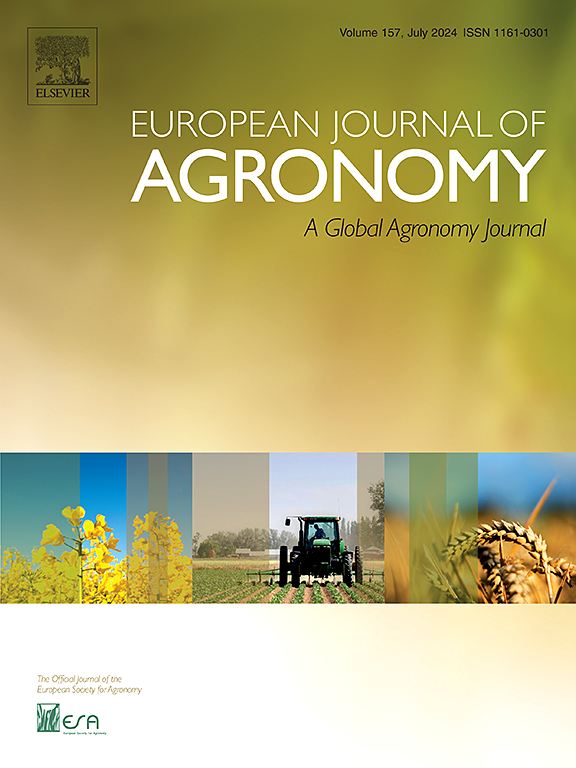一个新的数据集阐明不准确的温度阈值掩盖了普通小麦风险不确定性的隐藏来源
IF 4.5
1区 农林科学
Q1 AGRONOMY
引用次数: 0
摘要
温度超出每个物候期的最佳范围可能造成谷物产量损失。然而,对小麦热胁迫评价的温度阈值尚无共识。在气候风险评估中,科学文献中广泛使用的这些阈值几乎从未被考虑过。我们的综述更新了Porter和Gawith(1999)的开创性工作,根据地理定位、小麦类型、物候阶段和相关过程修订了热应激阈值。一组122份关于温度对小麦作物影响的出版物揭示了阈值的高度可变性和不一致性。我们解开了产生这种变异性的一些因素,并表明,当样品被地理位置、普通小麦类型(冬季或春季)和生物过程(生长或发育)过滤后,变异性在35-65 %的范围内下降,具体取决于压力指标。这种可变性导致对小麦作物的农业气候风险的估计存在相当大的不确定性。事实上,在法国,灌浆阶段的应力阈值(25°C vs. 27°C)相差2°C,在30年期间平均可将热应激风险(高于阈值的天数)降低高达45% %。这些结果通过考虑在可能值范围内选择的阈值位置如何导致低估或高估,有助于解释先前的研究。我们提供了本综述的完整数据库,包括定义每个研究阈值的有效性范围的元数据。我们建议未来的研究避免确定性阈值,而是使用一系列值来捕捉不确定性并尽量减少相互矛盾的结论。本文章由计算机程序翻译,如有差异,请以英文原文为准。
A new dataset to elucidate inaccurate temperature thresholds masking a hidden source of risk uncertainties in common wheat
Temperatures outside the optimum range for each phenological phase may wreak cereal yield losses. However, there is no consensus on temperature thresholds for assessing thermal stress in wheat. The wide spread use of these thresholds in the scientific literature is hardly ever considered in climate risk assessments. Our review updates the seminal work of Porter and Gawith (1999) by revising thermal stress thresholds, according to the geographical localisation, wheat type, phenological phases and processes involved. A group of 122 publications on the impact of temperature on wheat crops reveals high variability and inconsistencies in the thresholds. We disentangle some of the factors generating this variability and show that when the sample is filtered by geographical localisation, type of common wheat (winter or spring), and biological process (growth or development), the variability decreases within a range of 35–65 % depending on the stress indicator. This variability leads to considerable uncertainty in the estimation of agroclimatic risks to wheat crops. Indeed, a 2°C difference in the stress threshold (25°C vs. 27°C) for the grain-filling phase reduced the heat stress risk (number of days above the threshold) by up to 45 % on average over a 30-year period in France. These results help interpret previous studies by considering how the chosen threshold position within the range of possible values may lead to under or overestimation. We provide the full database from this review, including metadata defining the validity range of each study’s threshold. We recommend that future studies avoid deterministic thresholds and instead use a range of values to capture uncertainty and minimize conflicting conclusions.
求助全文
通过发布文献求助,成功后即可免费获取论文全文。
去求助
来源期刊

European Journal of Agronomy
农林科学-农艺学
CiteScore
8.30
自引率
7.70%
发文量
187
审稿时长
4.5 months
期刊介绍:
The European Journal of Agronomy, the official journal of the European Society for Agronomy, publishes original research papers reporting experimental and theoretical contributions to field-based agronomy and crop science. The journal will consider research at the field level for agricultural, horticultural and tree crops, that uses comprehensive and explanatory approaches. The EJA covers the following topics:
crop physiology
crop production and management including irrigation, fertilization and soil management
agroclimatology and modelling
plant-soil relationships
crop quality and post-harvest physiology
farming and cropping systems
agroecosystems and the environment
crop-weed interactions and management
organic farming
horticultural crops
papers from the European Society for Agronomy bi-annual meetings
In determining the suitability of submitted articles for publication, particular scrutiny is placed on the degree of novelty and significance of the research and the extent to which it adds to existing knowledge in agronomy.
 求助内容:
求助内容: 应助结果提醒方式:
应助结果提醒方式:


